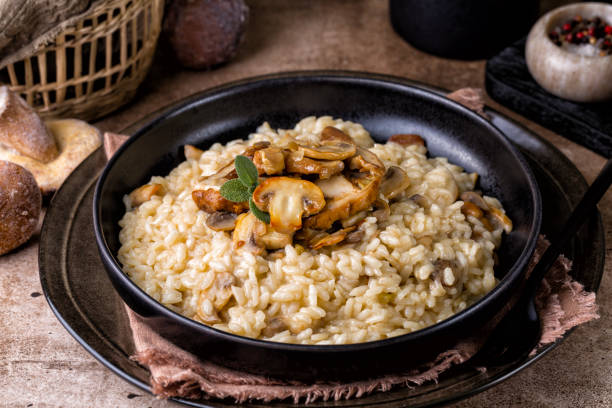
Risotto is one of those dishes that can make you feel like a gourmet chef, yet it’s surprisingly simple when you know the key techniques. It’s creamy, dreamy, and full of rich flavors, making it a comforting choice for any meal. The secret to perfect risotto lies in the technique: using the right rice, stirring constantly, and slowly adding the broth. In this guide, we’ll break down everything you need to know about making the perfect risotto, and share some delicious variations to keep things interesting.
Key Ingredients for the Perfect Risotto
Before we get into the steps, it’s important to understand the ingredients that will make your risotto both creamy and flavorful:
- Arborio Rice: The star of risotto is the rice, and Arborio rice is the best choice for the dish. Arborio rice is a short-grain rice with a high starch content, which is what gives risotto its signature creamy texture. You can also use other varieties like Carnaroli or Vialone Nano, but Arborio is the most common and accessible.
- Broth: The broth you use plays a huge role in the flavor of your risotto. Homemade stock is always ideal, but store-bought versions will work as long as you choose a high-quality one. Chicken, vegetable, or beef broth are all great options, depending on your flavor profile. Make sure to keep the broth warm while you’re cooking the risotto so it can absorb evenly.
- Fat: Butter and olive oil are commonly used to start the risotto. Butter adds richness and a creamy texture, while olive oil adds a bit of fruitiness. A combination of both gives you the best of both worlds.
- Aromatics: Onions, shallots, and garlic are typically sautéed at the beginning to add depth to the risotto’s flavor. Make sure to cook them gently in butter or oil until they are softened and translucent.
- Wine: A splash of dry white wine is often added after sautéing the aromatics, which helps to deglaze the pan and add acidity to balance the richness of the dish.
- Cheese: Parmesan or Pecorino Romano cheese is commonly stirred into the risotto at the end, creating a creamy, savory finish.
The Basic Steps to Making Risotto
Now, let’s go through the step-by-step process of making the perfect risotto.
1. Toast the Rice
Start by heating a tablespoon of butter and a tablespoon of olive oil in a large, heavy-bottomed pot or skillet over medium heat. Once the butter has melted, add finely chopped onions (or shallots) and sauté for about 2-3 minutes until soft and translucent.
Add the Arborio rice and cook it for 2-3 minutes, stirring constantly. This step is crucial for helping the rice release its starches as it cooks, which will contribute to the creamy texture of the risotto.
2. Deglaze with Wine
Once the rice is lightly toasted, add a ½ cup of dry white wine (such as Sauvignon Blanc or Chardonnay). Stir continuously until the wine is absorbed by the rice. The wine adds acidity and balances the richness of the dish.
3. Add the Broth Gradually
Now comes the most important step: adding the broth. Ladle in a small amount of warm broth (about ½ cup at a time), just enough to cover the rice. Stir constantly and wait until most of the liquid is absorbed before adding the next ladle of broth.
This process will take time, around 18-20 minutes in total, and you should continue adding the broth one ladle at a time, stirring constantly. Stirring helps release the rice’s starch, which gives risotto its signature creamy texture.
Be patient! It’s this slow addition of broth that creates the perfect creamy consistency.
4. Test for Doneness
After 18-20 minutes of stirring and adding broth, the rice should be tender but still have a slight al dente bite. Taste the rice, and if it’s still a bit firm in the center, continue adding broth and stirring for a few more minutes.
5. Finish with Butter and Cheese
Once the rice is cooked to your desired texture, remove the pot from the heat. Stir in 2 tablespoons of butter and a generous ½ cup of grated Parmesan cheese. This will add richness and flavor. Taste and season with salt and pepper as needed. If you prefer a slightly looser texture, you can add a bit more broth or a splash of cream.
Now, your basic risotto is ready to serve! But why stop there? You can easily customize your risotto by adding different flavors and ingredients.
Delicious Variations of Risotto
1. Mushroom Risotto
Mushroom risotto is a classic, earthy variation that’s perfect for mushroom lovers. To make it, sauté 1-2 cups of sliced mushrooms (cremini, shiitake, or porcini) in a separate pan with butter until browned. Add the cooked mushrooms to the risotto just before finishing it off with cheese and butter.
For an extra depth of flavor, you can add a splash of truffle oil or use a mixture of dried porcini mushrooms and their soaking liquid in the broth.
2. Seafood Risotto
Seafood risotto is a fantastic option for a special occasion or a fresh, flavorful dish. To make it, add a combination of shrimp, scallops, and/or mussels towards the end of the cooking process, just before the risotto is done. Stir the seafood into the risotto, allowing it to cook through (about 3-4 minutes). A squeeze of lemon and a sprinkle of fresh parsley are perfect finishing touches for a bright, fresh flavor.
Alternatively, you can use a seafood broth instead of chicken or vegetable broth for even more seafood flavor.
3. Lemon and Parmesan Risotto
Lemon and Parmesan risotto is light, refreshing, and perfect for spring or summer. To make this variation, stir in the zest and juice of one lemon during the final stages of cooking. The acidity from the lemon balances the richness of the cheese, creating a fresh, tangy flavor. Garnish with extra grated Parmesan and fresh herbs like thyme or basil for a vibrant, aromatic finish.
4. Butternut Squash Risotto
Butternut squash adds a lovely sweetness and richness to risotto. To make it, roast 2 cups of cubed butternut squash with olive oil, salt, and pepper until tender (about 20-25 minutes at 400°F). Once the risotto is nearly finished, stir the roasted squash into the rice. You can mash it slightly with a fork for a smoother texture or leave it in chunks for added bite. For extra creaminess, add a bit of cream or mascarpone cheese along with the butter and Parmesan.
5. Spinach and Ricotta Risotto
For a lighter, greener risotto, spinach and ricotta make a delicious combo. Sauté a few handfuls of fresh spinach until wilted and then stir it into the risotto near the end of cooking. Once finished, swirl in a few tablespoons of ricotta cheese for a creamy, indulgent texture that pairs beautifully with the spinach.
Common Mistakes to Avoid
- Not Stirring Enough: Stirring constantly is key to releasing the rice’s starch and achieving the creamy texture risotto is known for. Be sure to stir throughout the cooking process.
- Adding Too Much Broth at Once: Adding too much broth at once can result in a soupy, less creamy texture. Add the liquid slowly and allow it to absorb gradually.
- Overcooking the Rice: While risotto should be cooked until tender, it should still have a slight bite to it. Overcooking can make the rice mushy and less satisfying.
- Using Cold Broth: Always keep your broth warm while cooking. Cold broth will slow down the cooking process and can cause the rice to cook unevenly.
Perfect risotto may take a little time and attention, but the results are totally worth it. The creamy, comforting texture combined with rich flavors will have your guests (and yourself) coming back for more. Whether you opt for a classic mushroom risotto, a light lemon and Parmesan version, or a decadent seafood creation, mastering the technique will give you endless options for a dish that’s as versatile as it is delicious. So grab your Arborio rice, a pot of warm broth, and get ready to create a risotto that’s truly dreamy!
